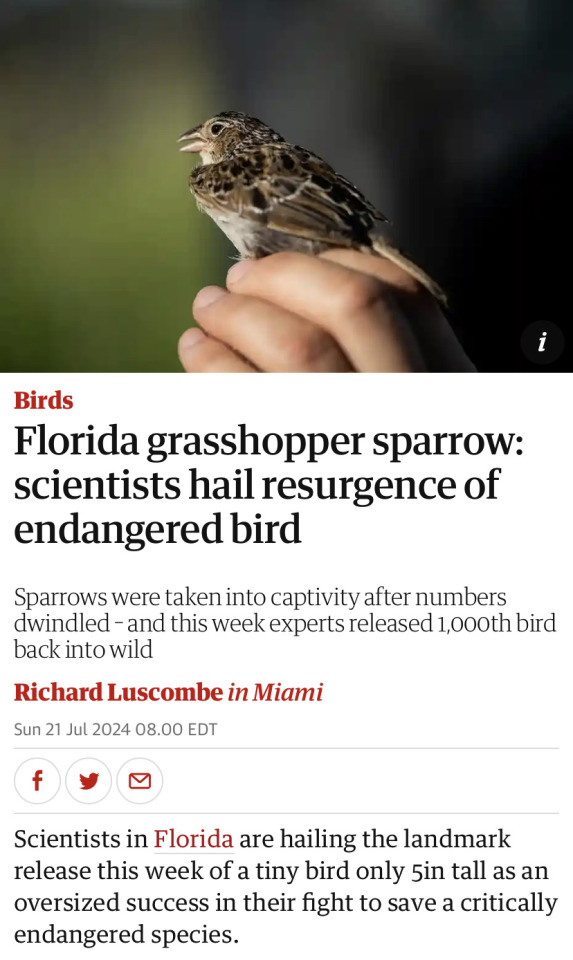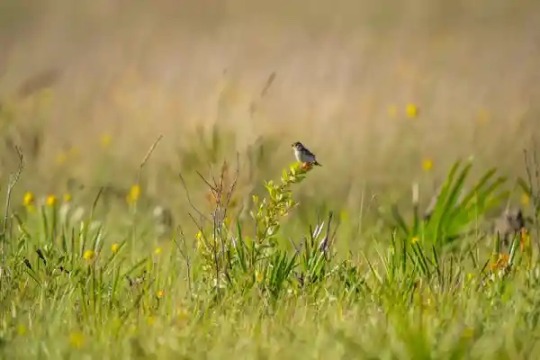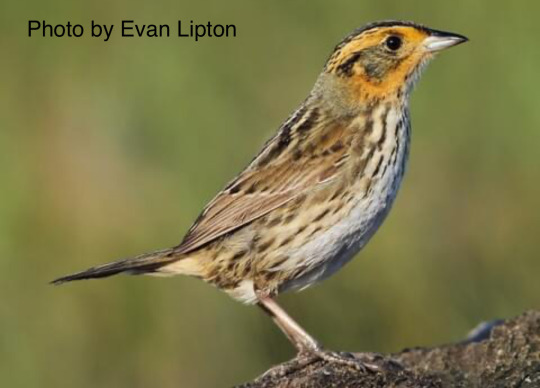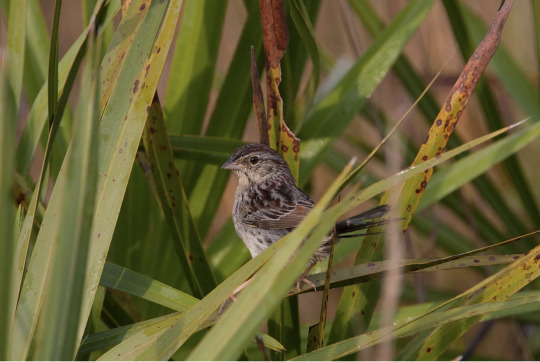#florida grasshopper sparrow
Explore tagged Tumblr posts
Text


WELCOME BACK LITTLE GUYS!!! conservation DOES have meaning even in a struggling world, and we still have the opportunity to make a difference
15K notes
·
View notes
Text
Excerpt from this story from Inside Climate News:
On a recent morning, 10 Florida grasshopper sparrows, tiny brown-speckled birds that are the most endangered on the continent, took their first scampers and flaps on the state’s central prairie.
It happened so fast it was hard to distinguish which of the captive-raised sparrows was the 1,000th released on this expanse of grasslands not far from Walt Disney World, the only place on Earth where the birds are found in their natural habitat.
Dozens of conservationists, gathered some distance away to avoid spooking the skittish sparrows, celebrated the milestone in an unprecedented recovery program that in only a few years has doubled the bird’s wild population, from a mere 80 five years ago to some 200 today.
By the time the land-dwelling sparrows emerged from the two large enclosures and disappeared onto the prairie, the observers couldn’t help but cheer. The moment marked the culmination of years of deliberation, doubt and diligence among those engaged in the bird’s fate, said Paul Gray, science coordinator for the Everglades Restoration Program at Audubon Florida.
“It’s just a lot of hard work by a whole lot of people,” said Gray, who has worked on the Florida grasshopper sparrow for about 30 years and was present for the 1,000th release in July. “I can’t describe how hard it was emotionally for everyone involved in this because every step of the way, we had to do something that nobody had done before.”
11 notes
·
View notes
Text

#florida grasshopper sparrow#sparrow#bird#birblr#conservation#florida#birds#most beautiful birds#stunning birds#unique birds
0 notes
Text

Florida Grasshopper Sparrow (Ammodramus savannarum floridanus)
Florida, USA
Status: Endangered
Threats: habitat loss, extreme weather, invasive species
#Grasshopper... Spotted!! ZOOM#birds#bird art#birdblr#artists on tumblr#species art#conservation#animals#bird#sparrow#passerine#usa#north america#florida
31 notes
·
View notes
Text
Me: I only read Federal Register Document from 1982-12-30 for the plot!
The plot:

#i just spent an embarrassing amount of time trying to track down Swallow Tail Kite in this document#i dont even know why#but i learned about some cool birds!#like the white crowned pigeon!#and the florida grasshopper sparrow!#and the tricolor blackbird!!!#i fucking love birds so much#edit: i accidentally wrote 1882 i meant 1982
1 note
·
View note
Note
Can you think of a better bird for Rhode Island?
My pick for Rhode Island might not be super popular since it’s a visually unexciting bird to some, but I would have the Saltmarsh Sparrow as my selection. With RI being the ocean state, I think this tidal bird would be appropriate. A little bird for a little state! The Saltmarsh sparrow is in a lot of trouble conservation-wise (similar to grasshopper sparrow in Florida) and many people in Rhode Island are moving heaven and earth to try and save them. I love RIR as a chicken breed but the Saltmarsh Sparrow is a native bird that could really use some good press.

80 notes
·
View notes
Text
Lowkey tho the urge to write a thingy about florida grasshopper sparrows but if they were little dragons,,,,
6 notes
·
View notes
Text
Florida’s Vanishing Sparrows
A group of eccentric endangered birds serves as a bellwether of the climate crisis.
— By Dexter Filkins |July 17, 2023

The survival of the Florida grasshopper sparrow is in doubt, but the scientists who are working to help the species refuse to give up.Photograph from Nature Picture Library/Alamy
The Avon Park Air Force Range, in central Florida, is a noisy place. Most weeks, American pilots practice dropping bombs and firing rockets there, turning old Humvees into clouds of scrap metal and smoke. Last month, a crowd gathered at the range to listen for the song of the Florida grasshopper sparrow—a faint chittering noise that evokes an insect’s buzz, giving the bird its name. As the crowd looked on expectantly, a group of tiny birds, small enough to fit in your palm, ventured tentatively from a pen, looked into the sunshine, and then flew away. The grasshopper sparrow, a modest and eccentric creature that inhabits the prairies of the central and southern parts of the state, is considered the most endangered bird in the continental United States. The birds at the bombing range were part of a program to bring their species back from the brink. “It will be hard, but we think this sparrow is worth saving,” Angela Tringali, a researcher at Archbold Biological Station, which is involved in the effort, told me.
With its subtropical climate, Florida hosts a vast array of wildlife that exists nowhere else in the county. But years of relentless human population growth have driven many to the vanishing point: Florida is home to sixty-seven species of threatened and endangered animals, among the highest numbers in the continental U.S. Those include the Miami blue butterfly, the Everglade snail kite, and the Florida panther, of which fewer than two hundred and fifty remain.
Birds that nest on or near the ground—like the Cape Sable seaside sparrow and the grasshopper sparrow—are especially vulnerable. Grasshopper sparrows can fly, but they spend most of their lives on the ground, nesting in clumps of tall grass. This provides easy access to the insects that they eat (though it also makes them susceptible to predators, like skunks and snakes). As more and more people moved to Florida, their habitat—in the prairies that used to cover much of the state south of Orlando—gave way to shopping centers and housing tracts.
For decades, scientists watched the sparrows’ numbers slowly ebb. In 1986, the U.S. Fish and Wildlife Service declared them endangered; by the end of the century, there were thought to be fewer than a thousand left. Shortly after that, the population began dropping precipitously, and by 2012 as few as seventy-five males remained. Beyond habitat loss, the reasons for the steep decline weren’t entirely clear, though some scientists suspected fire ants, an invasive species. “We started to panic,” Mary Peterson, an endangered species biologist with the U.S. Fish and Wildlife Service, said.
As the sparrows approached extinction, Peterson and other scientists decided that they couldn’t risk letting the bird continue to breed only in the wild. After identifying three concentrations of birds in protected habitats, and one on a private ranch, they gathered what adults they could and began breeding them in captivity around the state. Captive breeding is generally considered a last resort—some species of birds and other animals don’t survive it. But, Peterson said, “the risk of not doing anything could be catastrophic.” The scientists released their first batch of youngsters, a dozen birds, in 2019. Since then, they have bred and released more than seven hundred. In a good year, about a quarter of the chicks survive to adulthood in the wild; the release at the Avon Park bombing range last week brought the estimated number of birds to about two hundred and fifty.
The Avon Park range appears to be an especially promising venue for the birds. With more than a hundred thousand acres, it contains more than a dozen other threatened and endangered species. Twenty years ago, before populations collapsed, it was home to about three hundred grasshopper sparrows. The Department of Defense has proved to be an eager partner in preservation: Charles (Buck) MacLaughlin, the range operations officer, told me that the Air Force and the Fish and Wildlife Service periodically survey the landscape, when there aren’t air strikes scheduled. “I don’t think any have been killed there,” he told me.
Still, the survival of the grasshopper sparrow is in doubt. “Extinction is still a possibility,” Peterson said. The scientists aim to create ten protected sites of at least fifty breeding pairs each—a goal that is many years away, at best. The challenge is less in breeding sufficient numbers than in finding space for them; some ninety per cent of the bird’s historic habitat is gone. There are similar stories throughout the state. The Florida panther is making a modest comeback, but it’s constrained by human presence in the Everglades; last year, some twenty-five panthers were killed by cars. In the oceans off the coast, temperatures of ninety-plus degrees threaten coral reefs. But the scientists who are working to help the grasshopper sparrow refuse to give up. Tringali, the biologist, told me, “It’s really easy to do nothing. We are not done. We have a long way to go.” ♦
#Birds | Endangered Species | Florida | Environmentalism#The New Yorker#Dexter Filkins#The Avon Park Air Force Range#The Continental United States 🇺🇸#Angela Tringali#Archbold Biological Station#Miami Blue Butterfly | The Everglade Snail Kite | The Florida Panther#Orlando#U.S. Fish and Wildlife Service#Mary Peterson#Extinction#Charles (Buck) MacLaughlin#Air Force
3 notes
·
View notes
Text
A captivating drama from the frontlines of the race to save birds set against the devastating loss of one third of the avian population.
Three years ago, headlines delivered shocking news: nearly three billion birds in North America have vanished over the past fifty years. No species has been spared, from the most delicate jeweled hummingbirds to scrappy black crows, from a rainbow of warblers to common birds such as owls and sparrows. In a desperate race against time, scientists, conservationists, birders, wildlife officers, and philanthropists are scrambling to halt the collapse of species with bold, experimental, and sometimes risky rescue missions. High in the mountains of Hawaii, biologists are about to release clouds of laboratory-bred mosquitos in a last-ditch attempt to save Hawaii’s remaining native forest birds. In Central Florida, researchers have found a way to hatch Florida Grasshopper Sparrows in captivity to rebuild a species down to its last two dozen birds. In the Sierra Nevada Mountains, a team is using artificial intelligence to save the California Spotted Owl. In North Carolina, a scientist is experimenting with genomics borrowed from human medicine to bring the long-extinct Passenger Pigeon back to life. For the past year, veteran journalists Anders and Beverly Gyllenhaal traveled more than 25,000 miles across the Americas, chronicling costly experiments, contentious politics, and new technologies to save our beloved birds from the brink of extinction.
1 note
·
View note
Text
Conservation Breakthrough: 1,000th Florida Sparrow Grasshopper Released from Captivity

An important environmental event took place in Florida: conservationists celebrated the release of the 1,000th Florida grasshopper sparrow, bred in captivity. This unique species, which is under threat of extinction, has received a second chance at life in the wild thanks to the efforts of scientists and ecologists. The population restoration program, which began several years ago, has demonstrated significant success, and the release of the 1,000th individual was a real breakthrough in preserving the region's biodiversity.
https://eco-guardians.org/activities/conservation-breakthrough-1000th-florida-sparrow-grasshopper-released-from-captivity/
0 notes
Text
"The words 'bombing range' might evoke a desolate war zone. Avon Park is anything but. In fact, its 106,000 acres are home to scores of plants and animals that are endemic to Florida, as well as 13 threatened and endangered species, including Florida grasshopper sparrows (North America’s most endangered bird) and Florida bonneted bats (North America’s most endangered bat)." Story from the Smithsonian
0 notes
Audio
EP 155: Welcome to Florida: Saving the Grasshopper Sparrow 6-3-23 https://audioboom.com/posts/8311531-ep-155-welcome-to-florida-saving-the-grasshopper-sparrow-6-3-23
#<Tag:0x00007fbcef5ad710>#<Tag:0x00007fbcef5ad670>#<Tag:0x00007fbcef5ad5d0>#<Tag:0x00007fbcef5ad530>#<Tag:0x00007fbcef5ad490>#<Tag:0x00007fbcef5ad3f0>#<Tag:0x00007fbcef5ad350>
0 notes
Link

Excerpt from this story from National Geographic:
Ashleigh Blackford has seen her share of dramatic bird releases over the years. She vividly recalls California condors soaring high into the sky and San Clemente loggerhead shrikes fluttering free. The tiny Florida grasshopper sparrow, on the other hand, merely hopped out of an open screen and skittered along the ground, says Blackford, a U.S. Fish and Wildlife Service biologist.
Still, it was a thrilling moment to witness: one of the most endangered birds in the continental U.S.—one that just two years ago seemed doomed to extinction—had begun a remarkable comeback.
“It wasn’t visually exciting,” Blackford says, “but it was emotionally exciting.”
No more than five inches long, Florida grasshopper sparrows have flat heads, short tails, and black and gray feathers that camouflage their nests, built in the low shrubs and saw palmetto of the state’s grassy prairies. Their name comes from their call, which consists of two or three weak notes followed by an insect-like buzz.
The Florida grasshopper sparrow (Ammodramus savannarum floridanus) was first described in 1902 by a U.S. Army surgeon, Major Edgar A. Mearns. Back then the birds were widespread across central and South Florida. By the 1970s, though, most of the prairies that form their habitat had been ditched, drained, and converted to pastures or sod production.
By 1986, the sparrow population had plummeted to a mere thousand. By 2013, fewer than 200 of the little songbirds remained.
“This is an emergency, and the situation for this species is dire,” Larry Williams, head of the South Florida office of the Fish and Wildlife Service in Vero Beach, said at the time. “This is literally a race against time.”
To many, they’re just little brown birds. They’re not especially beautiful or exciting or awe-inspiring. And that is part of the challenge in saving them.
By 2018, only 80 birds remained in the wild, including just 20 breeding pairs, says Craig Faulhaber, avian conservation coordinator for the Florida Fish and Wildlife Conservation Commission. If this trend continued, “there was a strong possibility for extinction,” he says.
The wild population now numbers about a hundred, with 30 breeding pairs. It’s an improvement, Faulhaber says, although still far from the point of declaring them no longer endangered, so the captive-breeding program continues.
Meanwhile, in a deal announced in November, the family of deceased Subway co-founder Fred DeLuca donated 27,000 acres of undeveloped ranchland for preservation—land that contains about half of all the breeding pairs. It’s also critical link in the Florida wildlife corridor, a network of wild and rural lands that, once complete, will allow other rare animals, including the endangered Florida panther, to move more easily throughout the state.
942 notes
·
View notes
Photo

Breeding program boosts endangered Florida grasshopper sparrow population | The Guardian
America’s bird populations may be facing an existential crisis but there is a glimmer of hope for one endangered species at least, with a breeding program helping dramatically boost the population of the endangered Florida grasshopper sparrow.
Around 50 of the birds, found in the prairies of south-central Florida, were estimated to be in the wild in 2018, down from 1,000 in little more than decade. But a conservation program has, for the first time, now successfully reared 100 Florida grasshopper sparrows and released them back into their natural environment.
The sparrow has been listed as endangered by the US Fish and Wildlife Service since 1986 and has suffered steep declines in its population since then.
A shy, ground-nesting bird, the Florida grasshopper sparrow has experienced a huge reduction in its habitat, with vast tracts of its preferred grassland prairie turned into pastures for cattle. Altered flooding and fire regimes have also hurt the species, as well as the spread of the red fire ant, an invasive species that can attack the birds’ eggs.
A conservation program involving federal, state and non-government partners has aimed to reverse this, with 100 birds released into the wild and further breeding program planned for next year. All the birds have been tagged in order to monitor the population’s progress.
The White Oak wildlife refuge, just north of Jacksonville in Florida, handled the breeding program in what it calls a “naturalistic” way, by setting controlled fires that regenerated the prairie habitat and requiring the birds to forage for their own insects.
“We hope that this will help them to survive,” said Brandon Speeg, director of conservation at White Oak. “We won’t be able to tell until spring 2020 but we hope we will then see a lot of the birds during the breeding program then. We don’t want this going on forever but we hope if we do this for the next five years we can get the species out of immediate danger.”
#Florida Grasshopper Sparrow#Grasshopper Sparrow#Ammodramus savannarum floridanus#Ammodramus savannarum#Ammodramus#Passerellidae#Passeroidea#Passerida#Passeri#Passeriformes#Psittacopasserae#Eufalconimorphae#Aves#birds#sparrow#endangered#conservation#Florida
11 notes
·
View notes
Note
Hello! I hope you’re doing well! :)
Do you have a bird you’d prefer as Florida’s state bird?
I’ve heard a lot of criticism over the choice of a mockingbird and I’d like to see what you think
I love northern mockingbirds but definitely not as Florida’s state bird. There are SO many better options! Here are my gentle (violent) suggestions for replacement
1. Florida scrub jay
2. Roseate spoonbill
3. Swallow-tailed kite
4. Grasshopper sparrow
5. Crested Caracara (though this would actually be my primary pick for Texas)
36 notes
·
View notes
Text

I'm an avian ecology field technician, so I do fieldwork for bird research and conservation. rn I'm with a group that does stuff with Florida Grasshopper Sparrows (endangered subspecies of grasshopper sparrow, wild population in the low hundreds), so a lot of my job atm is trying to find their nests so we can put up anti-predator fences and stuff to protect them better.
Which means I get to go out in a field starting at like 5:30am and watch what the birds do and where they go to narrow down where their nest is and hopefully eventually find it. Except only the male perches in obvious places and sings obviously, and it's the female who's actually gonna make it easier to find the nest since she's the one incubating. So you watch the male and hope that he ends up hanging out with the female for at least a bit so that you know what areas she hangs out in. And then you search every clump of grass in the area for the nest. And a lot of times the nest isn't actually there bc the birds are just in the area to eat bugs. And the birds can dissappear in 2in of grass, and the clumps are a lot bigger than that. So you can't see them like 90% of the time they're walking around on the ground, which is a thing they love to do.
We've been looking for this nest in the picture for almost 2 weeks now.
It's objectively good that small birds can completely disappear in 2in of grass but also it makes my job so fucking difficult bc these sparrows love to run on the ground so much
#its fun but also can get irritating when you get nothing new for the nth day in a row#They're so cute tho#birds
76 notes
·
View notes